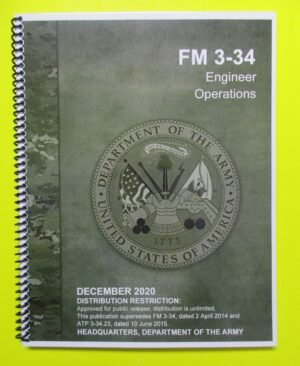Dated 2 February 2021
ATP 3-34.10 provides a doctrinal foundation for all engineer platoons. It provides the basic information for employment of engineer platoons in support of unified land operations.
The principal audience for ATP 3-34.10 is commanders, staffs, and leaders who are responsible for planning, preparing, executing, and assessing engineer platoons and squads. It serves as an authoritative reference for personnel developing doctrine materiel and force structure, institutional and unit training, and standard operating procedures (SOPs) for engineer platoons and squads.
ATP 3-34.10 applies to the Active Army, Army National Guard/Army National Guard of the United States, and United States Army Reserves unless otherwise stated.
ATP 3-34.10 provides engineer doctrine for engineer platoons within the framework of unified land operations. This manual also provides greater detail for engineer platoons to ensure the synchronization of engineer capabilities across the range of military operations.
The following is a brief introduction of each chapter:
l Chapter 1 outlines the OE which engineers operate in, as well as the broad climes associated with operations. The chapter goes on to discuss platoon leadership and their roles and responsibilities. Finally, the chapter describes and discusses the capabilities of the regiment, the organizations in which all engineers reside, and the mission sets those units undertake.
Chapter 2 introduces the three primary types of brigade combat teams (BCTs) and their basic capabilities. It also discusses the basics of offensive, defensive, and stability operations, which are discussed more in depth in later chapters. This chapter discusses platoon-level movement and maneuver techniques and hand and arm signals used when other forms of communication are less effective.
Chapter 3 describes command, control, and mission command. It goes further to describe the receiving organizations responsibilities. It also provides platoons with considerations of information to provide when task-organized to a supported unit.
Chapter 4 discusses the planning and preparation platoons must do. This chapter also discusses reconnaissance, rehearsals, pre-combat checks, and pre-combat inspections.
Chapter 5 provides a description of the geospatial capability and contribution to operations. This chapter also provides platoons with descriptions of geospatial products available to units during planning and operations.
Chapter 6 outlines the platoon’s role in mobility from breaching to clearing. It also touches on gap crossing and combat roads and trails.
Chapter 7 provides platoons with the primary planning principles for countermobility and survivability. This chapter also describes the platoon’s contribution to consolidate gains.
Chapter 8 introduces stability operations and defense support of civil authorities (DSCA). The chapter depicts engineer tasks supporting these areas.
Chapter 9 describes the general engineering discipline’s contribution to operations across the range of military operations. This chapter also describes the general engineering supply support requirements during the phases of operations.
Chapter 10 summarizes indirect fires and air support capabilities. It also informs users of the reaction times for support from indirect fires.
Chapter 11 summarizes the basics of sustainment at the platoon level.
This book is a “mini” (7 1/4 inches high by 5 1/2 inches wide) size – A popular size to carry anywhere (briefcase, large pocket, purse) but the print is large enough for easy reading. It has coil binding, allowing for easy page flipping withing jamming.
(If you want a BIG size (the size of a regular sheet of paper), we have it on this website too)





